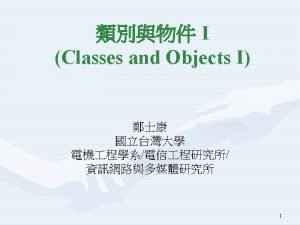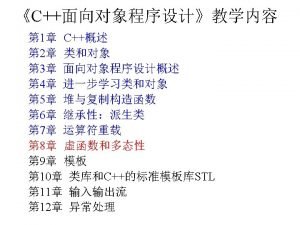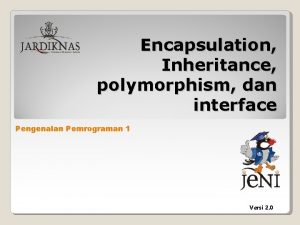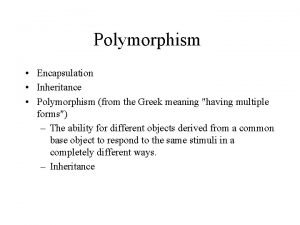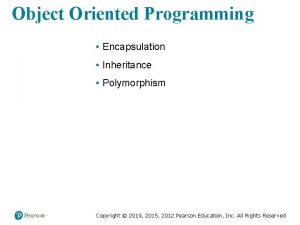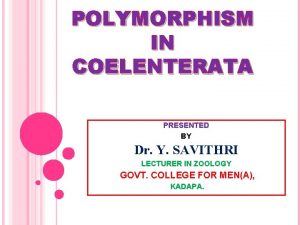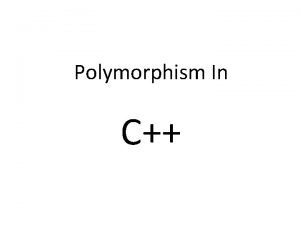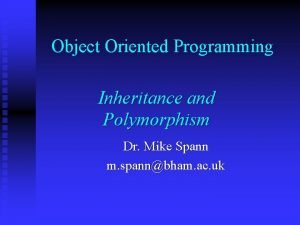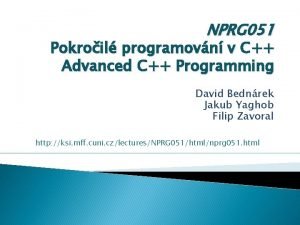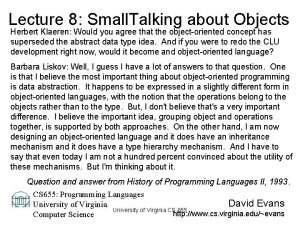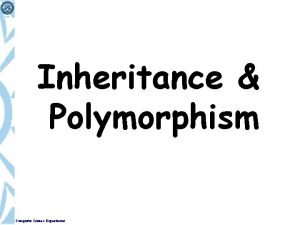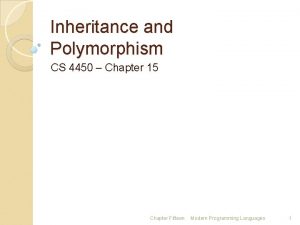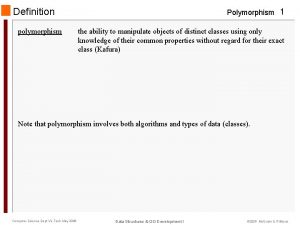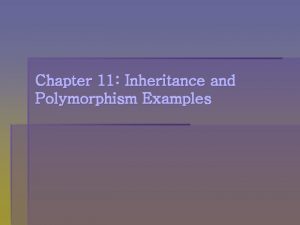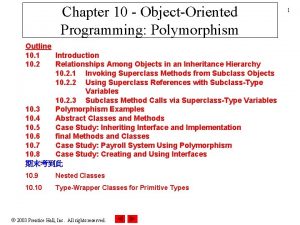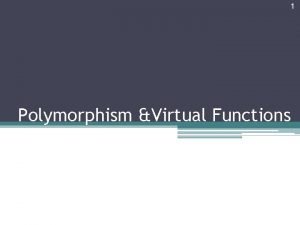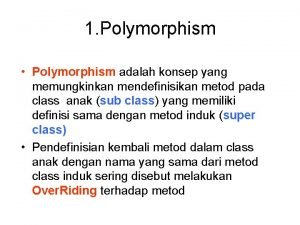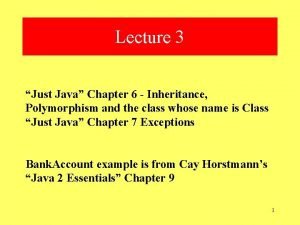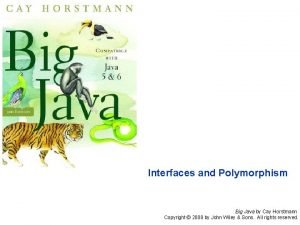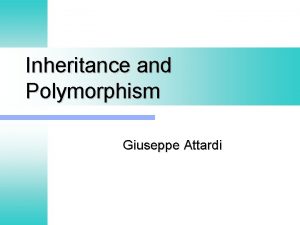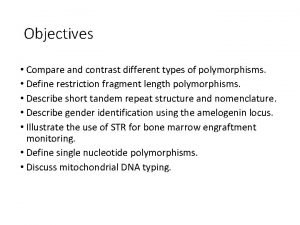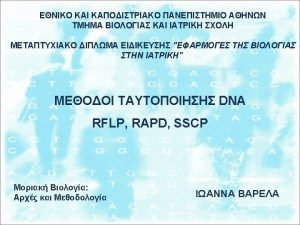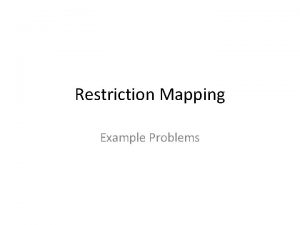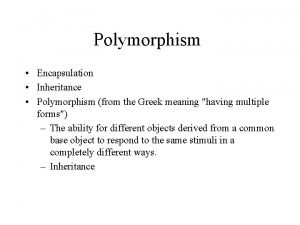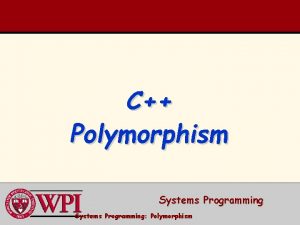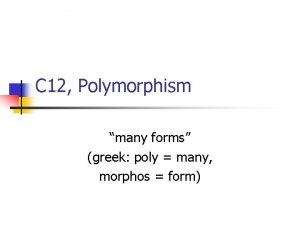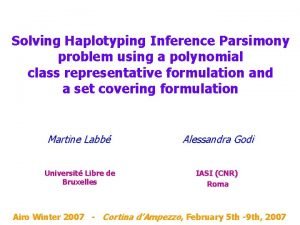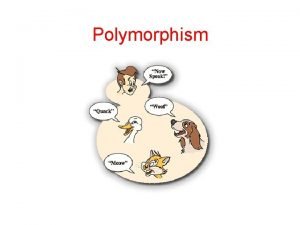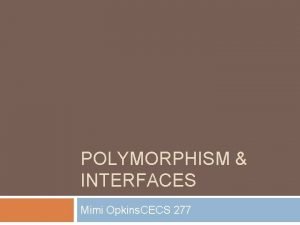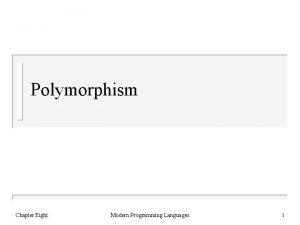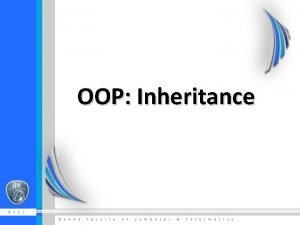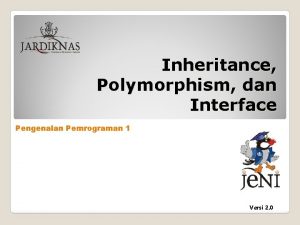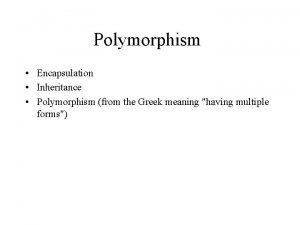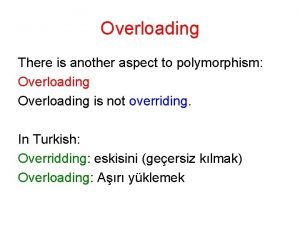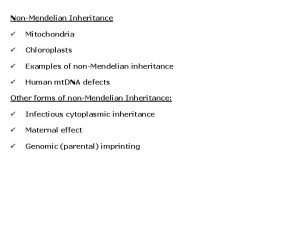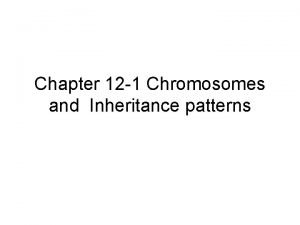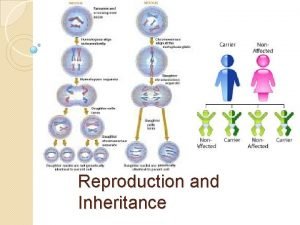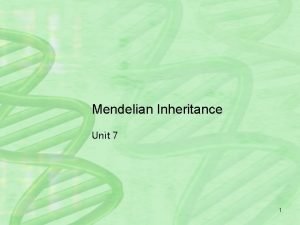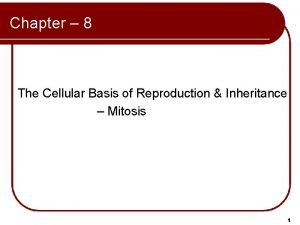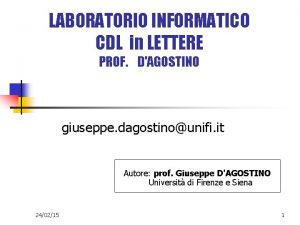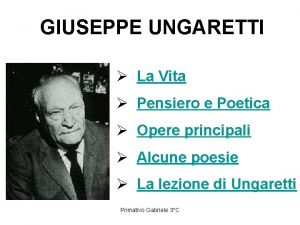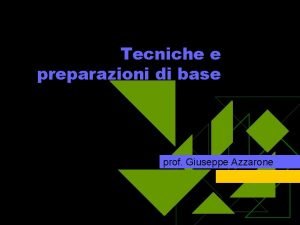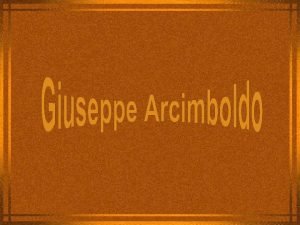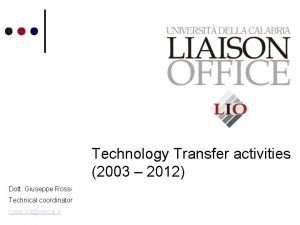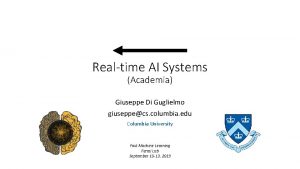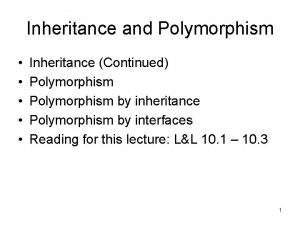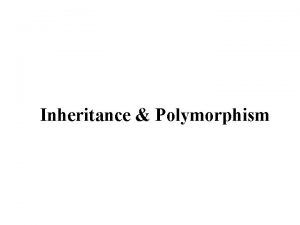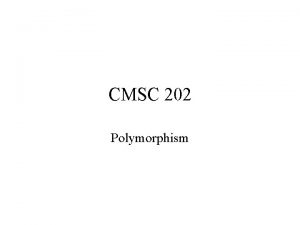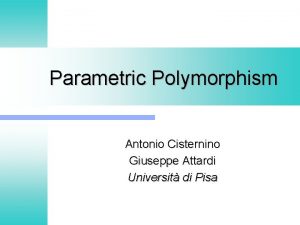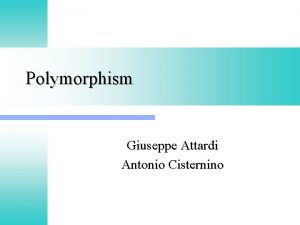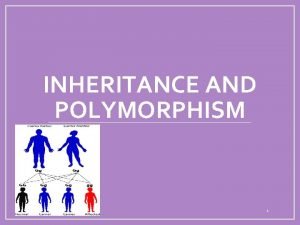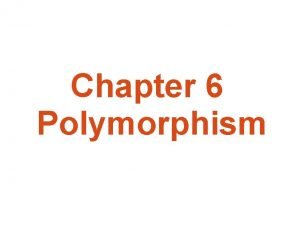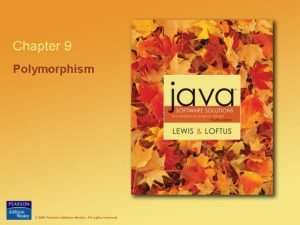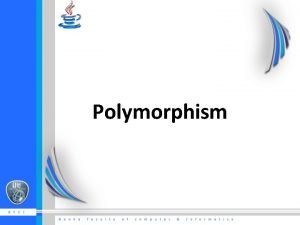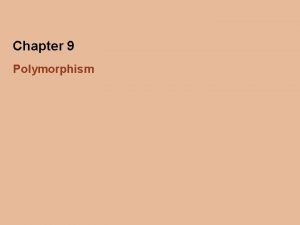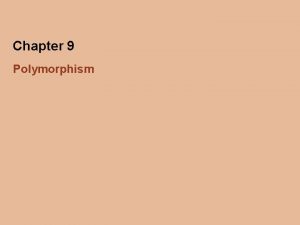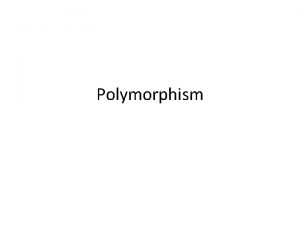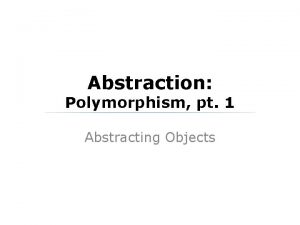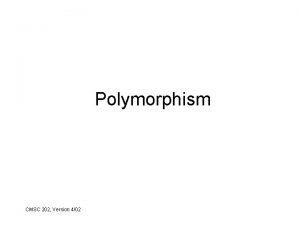Inheritance and Polymorphism Giuseppe Attardi What You Will



































































































- Slides: 99

Inheritance and Polymorphism Giuseppe Attardi

What You Will Learn l What is polymorphism l Notions – virtual methods – abstract classes – Liskov Substitution Principle l Techniques – vtable – late binding

Motivations

Inheritance and Polymorphism l Code Factoring l Extensibility l Reuse

Problem with Variety of Types l Given these types of objects: Circle l Triangle Rectangle Square There are functions for drawing each object: – – draw_circle() draw_triangle() draw_rectangle() draw_square() Consider a picture made of several such of objects l How do you draw the picture? l

Solution: Polymorphism l Create a class hierarchy: Shape Circle Triangle Rectangle Square l Add (virtual) method draw() in each class l Invoke method draw() on each element of the picture l How do you draw() a Shape object?

Polymorphism l When a program invokes a method through a superclass variable, – the correct subclass version of the method is called, – based on the type of the object stored in the superclass variable l The same method name and signature can cause different actions to occur, – depending on the type of object on which the method is invoked 7

Introduction l Polymorphism – Enables “programming in the general” – The same method invocation can take “many forms” l Interfaces – Specify common functionality for possibly unrelated classes

Polymorphism l Polymorphism enables programmers to deal in generalities and – Let the specifics be determined at run time l Programmers can command objects to behave in manners appropriate to those objects, – without knowing the specific types of the objects – as long as the objects belong to the same inheritance hierarchy

Polymorphism Promotes Extensibility l Software that invokes polymorphic methods – stays independent of the object types on which methods are invoked l New object types that can respond to existing method calls can be – added to a system without requiring modification to the code that uses them l Only client code that instantiates new objects must know about new types

Requirements for Polymorphism l Inheritance Hierarchy – Subclass – Interfaces l Virtual Methods – Explicit keyword virtual (C++, C#) – Implicit (Java [unless final], Python, etc. )

Some Theory

Liskov Substitution Principle l Sub-Typing/Sub-Classing defines the class relation “B is a sub-type of A”, marked B <: A. l According to the substitution principle, if B <: A, then an object of type B can be substituted for an object of type A. l Therefore, it is legal to assign an instance b of B to a variable of type A A a = b;

Subtyping l Class Inheritance: § if class B derives from class A then: B <: A l Interface Inheritance: § If class B implements interface A then: B <: A

Demonstrating Polymorphic Behavior l A variable of one type can be assigned a value of a subclass – a subclass object “is-a” superclass object – the type of the actual object, not the type of the variable, determines which method is called

Inheritance: Single or Multiple

l Multiple inheritance: – C++ l Single class inheritance, but multiple interface inheritance: – Java, C#

Hierarchy

Root of Hierarchy l Abstract class l Interface

Abstract Classes and Methods l Abstract classes – Are root of a class hierarchy – Cannot be instantiated – Incomplete • subclasses fill in the "missing pieces" l Concrete classes – Can be instantiated – Implement every method they declare – Provide specifics

Abstract Classes l Declares common attributes and behaviors of the various classes in a class hierarchy. l Typically contains one or more abstract methods – Subclasses must override if the subclasses are to be concrete. l Instance variables and concrete methods of an abstract class subject to the normal rules of inheritance.

Abstract Classes l Classes that are too general to create real objects l Used only as abstract superclasses for concrete subclasses and to declare reference variables l Many inheritance hierarchies have abstract superclasses occupying the top few levels

Keyword abstract l Used for declaring a class abstract l Also used for declaring a method abstract l Abstract classes normally contain one or more abstract methods l All concrete subclasses must override all inherited abstract methods

C++ Abstract Classes l C++ has no keyword abstract l A class is abstract if it has a pure virtual method: class Shape { public: void virtual draw() = 0; // pure virtual … ; {

C++ Interfaces l C++ has no keyword interface l An abstract class can play a role of an interface since l C++ has multiple inheritance

Abstract Classes and Methods l Iterator class – Traverses all the objects in a collection, such as an array – Often used in polymorphic programming to traverse a collection that contains objects from various levels of a hierarchy

Beware! Compile Time Errors l Attempting to instantiate an object of an abstract class l Failure to implement a superclass’s abstract methods in a subclass – unless the subclass is also declared abstract.

Creating Abstract Superclass Employee labstract superclass Employee, earnings is declared abstract • No implementation can be given for earnings in the Employee abstract class – An array of Employee variables will store references to subclass objects • earnings method calls from these variables will call the appropriate version of the earnings method

Example Based on Employee Abstract Class Concrete Classes Click on Classes to see source code

Polymorphic interface for the Employee hierarchy classes.

Note in Example Hierarchy u Dynamic binding – Also known as late binding – Calls to overridden methods are resolved at execution time, based on the type of object referenced u instanceof operator – Determines whether an object is an instance of a certain type

How Do They Do That? u How does it work? – Access a derived object via base class pointer – Invoke an abstract method – At run time the correct version of the method is used u Design of the vtable – Note description from C++

Note in Example Hierarchy l Downcasting – Convert a reference to a superclass to a reference to a subclass – Allowed only if the object has an is-a relationship with the subclass l get. Class method – Inherited from Object – Returns an object of type Class l get. Name method of class – Returns the class’s name Class

Inheritance l If the class A inherits from class B (A<: B) when an object of class B is expected an object of class A can be used instead l Inheritance expresses the idea of adding features to an existing type (both methods and attributes) l Inheritance can be single or multiple

Example class int int } class int } A { i; j; foo() { return i + j; } B : A { k; foo() { return k + super. foo(); }

Questions l Consider the following: A a = new A(); A b = new B(); Console. Write. Line(a. foo()); Console. Write. Line(b. foo()); Which version of foo is invoked in the second print? l What is the layout of class B? l

Upcasting l Late binding happens because we convert a reference to an object of class B into a reference of its super-class A (upcasting): B b = new B(); A a = b; The runtime should not convert the object: only use the part inherited from A l This is different from the following implicit cast where the data is modified in the assignment: l int i = 10; long l = i;

Downcasting l Once we have a reference of the superclass we may want to convert it back: A a = new B(); B b = (B)a; During downcast it is necessary to explicitly indicate which class is the target: a class may be the ancestor of many sub-classes l Again this transformation informs the compiler that the referenced object is of type B without changing the object in any way l

Upcasting, downcasting We have shown upcasting and downcasting as expressed in languages such as C++, C# and Java; though the problem is common to OO languages l Note that the upcast can be verified at compile time whereas the downcast cannot l Upcasting and downcasting do not require runtime type checking: l – in Java casts are checked at runtime – C++ simply changes the interpretation of an expression at compile time without any check at runtime

Late Binding The output of invoking b. foo() depends on the language: the second output may be the result of invoking A: : foo() or B: : foo() l In Java the behavior would result in the invocation of B: : foo l In C++ A: : foo would be invoked l The mechanism which associates the method B: : foo() to b. foo() is called late binding l

Late Binding l l l In the example the compiler cannot determine statically the exact type of the object referenced by b because of upcasting To allow the invocation of the method of the exact type rather than the one known at compile time it is necessary to pay an overhead at runtime Programming languages allow the programmer to specify whether to apply late binding in a method invocation In Java the keyword final is used to indicate that a method cannot be overridden in subclasses: thus the JVM may avoid late binding In C++ only methods declared as virtual are considered for late binding

Late Binding l l With inheritance it is possible to treat objects in a generic way The benefit is evident: it is possible to write generic operations manipulating objects of types inheriting from a common ancestor OOP languages usually support late binding of methods: which method should be invoked is determined at runtime This mechanism involves a small runtime overhead: at runtime the type of an object should be determined in order to invoke its methods

Example (Java) class A { final void foo() {…} void baz() {…} void bar() {…} } class B extends A { // Suppose it’s possible! final void foo() {…} void bar(); } A B A a b c = = = new A(); new B(); b; a. foo(); a. baz(); a. bar(); b. foo(); b. bar(); c. foo(); c. bar(); // // A: : foo() A: : baz() A: : bar() B: : foo() B: : bar() A: : foo() B: : bar()

Abstract classes l Sometimes it is necessary to model a set S of objects which can be partitioned into subsets (A 0, … An) such that their union covers S: – x S Ai S, x Ai l If we use classes to model each set it is natural that – A S, A<: S Each object is an instance of a subclass of S and no object is an instance of S. l S is useful because it abstracts the commonalities among its subclasses, allowing to express generic properties about its objects. l

Example l l l We want to manipulate documents with different formats The set of documents can be partitioned by type: doc, pdf, txt, and so on For each document type we introduce a class that inherits from a class Doc that represents the document In the class Doc we may store common properties to all documents (title, location, …) Each class is responsible for reading the document content It doesn’t make sense to have an instance of Doc though it is useful to scan a list of documents to read

Abstract methods Often when a class is abstract some of its methods could not be defined l Consider the method read() in the previous example l In class Doc there is no reasonable implementation for it l We leave it abstract so that through late binding the appropriate implementation will be called l

Syntax l Abstract classes can be declared using the abstract keyword in Java or C#: abstract class Doc { … } l C++ assumes a class is abstract if it contains an abstract method – it is impossible to instantiate an abstract class, since it will lack that method l A virtual method is abstract in C++ if its definition is empty: virtual string Read() = 0; l In Java and C# abstract methods are annotated with abstract and no body is provided: abstract String Read();

Inheritance is a relation among classes Often systems impose some restriction on inheritance relation for convenience l We say that class A is an interface if all its members are abstract; has no fields and may inherit only from one or more interfaces l Inheritance can be: l l – Single (A <: B ( C. A <: C C = B)) – Mix-in (S = {B | A <: B}, 1 B S ¬interface(B)) – Multiple (no restriction)

Multiple inheritance Why systems should impose restrictions on inheritance? l Multiple inheritance introduces both conceptual and implementation issues l The crucial problem, in its simplest form, is the following: l – B <: A C <: A – D <: B D <: C l In presence of a common ancestor: – The instance part from A is shared between B and C – The instance part from A is duplicated This situation is not infrequent: in C++ ios: >istream, ios: >ostream and iostream<: istream, iostream<: ostream l The problem in sharing the ancestor A is that B and C may change the inherited state in a way that may lead to conflicts l

Java and Mix-in inheritance l l l Both single and mix-in inheritance fix the common ancestor problem Though single inheritance can be somewhat restrictive Mix-in inheritance has become popular with Java and represents an intermediate solution Classes are partitioned into two sets: interfaces and normal classes Interfaces constraints elements of the class to be only abstract methods: no instance variables are allowed A class inherits instance variables only from one of its ancestors avoiding the diamond problem of multiple inheritance

Implementing Single and Mix-in inheritance that Upcasting andthe Downcasting comes l Consists only in. Note combining state of for free: the pointer at the base of the instance can be seen both as a pointer to an instance of A or B a class and its super-classess A B<: A C<: B<: A D<: C<: B<: A A A B B B D

Implementing multiple inheritance l With multiple inheritance becomes more complex than reinterpreting a pointer! A B<: A C<: A D<: B, D<: C A A A (B) B C B A (C) C D B C D

Late binding l l l l How to identify which method to invoke? Solution: use a v-table for each class that has polymorphic methods Each virtual method is assigned a slot in the table pointing to the method code Invoking the method involves looking up in the table at a specific offset to retrieve the address to use in the call instruction Each instance holds a pointer to the v-table Thus late binding incurs an overhead both in time (2 indirections) and space (one pointer per object) The overhead is small and often worth the benefits

Late binding: an example (Java) A’s v-table class A { void foo() {…} void f() {…} int ai; } class B extends A { void foo() {…} void g() {…} int bi; } A a = new A(); a. foo(); a. f(); foo f V-pointer a ai b B’s v-table foo f g B b = new B(); b. foo(); b. g(); b. f(); V-pointer ai bi A c = b; c. foo(); c. f(); c

Overriding and Overloading A’s v-table class A { void foo() {…} void f() {…} int ai; } class B extends A { void foo(int i) {…} void g() {…} int bi; } foo() f V-pointer a ai b B’s v-table foo() f foo(int) V-pointer ai bi g A a = new A(); a. foo(); a. f(); B b = new B(); b. foo(); b. g(); b. f(); A c = b; c. foo(3); c. f(); c

JVM invokevirtual l A call like: l is translated into: x. equals("test") aload_1 ; push local variable 1 (x) onto the operand stack ldc "test" ; push string "test" onto the operand stack invokevirtual java. lang. Object. equals(Ljava. lang. Object; )Z where java. lang. Object. equals(Ljava. lang. Object; )Z is a method specification l When invokevirtual is executed, the JVM looks at method specification and determines its # of args l From the object reference it retrieves the class, searches the list of methods for one matching the method descriptor. l If not found, searches its superclass l

Invokevirtual optimization The Java compiler can arrange every subclass method table (mtable) in the same way as its superclass, ensuring that each method is located at the same offset l The bytecode can be modified after first execution, by replacing with: l invokevirtual_quick mtable-offset l Even when called on objects of different types, the method offset will be the same

Virtual Method in Interface Optimization does not work for interfaces interface Incrementable { public void incr(); } class Counter implements Incrementable { public void incr(); } class Timer implements Incrementable { public void decr(); public void inc(); } Incrementable i; i. incr(); l Compiler cannot guarantee that method incr() is at the same offset. l

Runtime type information l Execution environments may use the v- table pointer as a mean of knowing the exact type of an object at runtime l This is what happens in C++ with RTTI, in. NET CLR and JVM l Thus the cost of having exact runtime type information is allocating the vpointer to all objects l C++ leaves the choice to the programmer: without RTTI no v-pointer is allocated in classes without virtual methods

Superclass And Subclass Assignment Rules u Assigning a superclass reference to superclass variable straightforward u Subclass reference to subclass variable straightforward u Subclass reference to superclass variable safe – because of is-a relationship – Referring to subclass-only members through superclass variables a compilation error u Superclass reference to a subclass variable a compilation error – Downcasting can get around this error

final Methods and Classes l final methods – Cannot be overridden in a subclass – private and static methods implicitly final – final methods are resolved at compile time, this is known as static binding • Compilers can optimize by inlining the code l final classes – Cannot be extended by a subclass – All methods in a final class implicitly final

Interfaces

Why Use Interfaces l Java has only single inheritance l A child class inherits from only one parent class l Sometimes multiple inheritance would be convenient l Interfaces give Java some of the advantages of multiple inheritance without incurring the disadvantages

Why Use Interfaces l Provide capability for unrelated classes to implement a set of common methods l Define and standardize ways people and systems can interact l Interface specifies what operations must be permitted l Does not specify how performed

What is an Interface? l An interface is a collection of constants and method declarations l An interface describes a set of methods that can be called on an object l The method declarations do not include an implementation – there is no method body

What is an Interface? l A child class that extends a parent class can also implement an interface to gain some additional behavior l Implementing an interface is a “promise” to include the specified method(s) l A method in an interface cannot be made private

When A Class Definition Implements An Interface l It must implement each method in the interface l Each method must be public (even though the interface might not say so) l Constants from the interface can be used as if they had been defined in the class (They should not be redefined in the class)

Declaring Constants with Interfaces l. Interfaces can be used to declare constants used in many class declarations – These constants are implicitly public, static and final – Using a static import declaration allows clients to use these constants with just their names

Class vs. Interface Inheritance Class Inheritance Functionality high in the hierarchy l Each new subclass inherits one or more methods declared in superclass l Subclass uses superclass declarations l Interface Inheritance Functionality lower in hierarchy l Superclass specifies one or more abstract methods l Must be declared for each class in hierarchy l Overridden for subclass-specific implementations l

Creating and Using Interfaces u Declaration begins with interface keyword u Classes implement an interface (and its methods) u Contains public abstract methods – Classes (that implement the interface) must implement these methods

Creating and Using Interfaces l Consider the possibility of having a class which manipulates mathematical functions l You want to send a function as a parameter – Note that C++ allows this directly – Java does not l This task can be accomplished with interfaces

Creating and Using Interfaces l Declare interface Function l Declare class My. Function which implements Function l Note other functions which are subclass objects of My. Function l View test program which passes Function subclass objects to function manipulation methods

Case Study: A Payable Hierarchy l Payable interface – Contains method get. Payment. Amount – Is implemented by the Invoice and Employee classes

Source Code for Shape Superclass Hierarchy l Shape superclass, Figure 10. 6 – Note abstract method, get. Name l Point subclass, Figure 10. 7 – Note, extends Shape, override of get. Name l Circle subclass, Figure 10. 8 – Note extends Point, override of get. Area, get. Name, and to. String l Cylinder subclass, Figure 10. 9 – Note extends Circle, override of get. Area, get. Name, and to. String

Source Code for Shape Superclass Hierarchy u Driver program to demonstrate, Note array of superclass references u Output of program

Polymorphic Payroll System Employee Salaried. Employee Commission. Employee Hourly. Employee Base. Plus. Commission. Employee Class hierarchy for polymorphic payroll application

Polymorphic Payroll System l Abstract superclass, Employee, Figure 10. 12 – Note abstract class specification, abstract earnings method l Abstract subclass, Salaried. Employee, Figure 10. 13 – Note extends Employee, override of earnings method l Look at other subclasses in text, pg 461 … – Note here also the override of earnings

Polymorphic Payroll System l View test program – Note array of superclass objects which are pointed at various subclass objects – Note generic calls of to. String method – Note use of instantceof operator – Consider use of downcasting – Note use of get. Class(). get. Name() method • Gives access to the name of the class 78

class Commission. Employee { public: Commission. Employee( const string &, double = 0. 0 ); void set. First. Name( const string & ); // set first name string get. First. Name() const; // return first name void set. Last. Name( const string & ); // set last name string get. Last. Name() const; // return last name void set. Social. Security. Number( const string & ); // set SSN string get. Social. Security. Number() const; // return SSN void set. Gross. Sales( double ); // set gross sales amount double get. Gross. Sales() const; // return gross sales amount

void set. Commission. Rate( double ); // set commission rate double get. Commission. Rate() const; // return commission rate double earnings() const; // calculate earnings private: string first. Name; string last. Name; string social. Security. Number; double gross. Sales; // gross weekly sales double commission. Rate; // commission percentage

Polymorphic Payroll System l Output of the payroll testing program l Note results of get. Class(). get. Name() calls 81

Creating and Using Interfaces l View implementation of the interface Shape, Figure 10. 19 Note the following: – Line 4 public class Point extends Object implements Shape { … – Declaration of additional methods – Declaration of abstract methods get. Area, get. Volume, and get. Name

Nested Classes u Top-level classes – Not declared inside a class or a method u Nested classes – Declared inside other classes – Inner classes u. Non-static nested classes u Demonstrated in Figure 10. 22 – Run the program – Audio

Mentioned In The Audio l Inheritance Hierarchy Object Component l Panes of a JFrame – Background – Content – Glass Container Window Frame JFrame

Mentioned In The Audio l Three things required when performing events 1. Implement the interface 2. Register the event handlers 3. Specifically implement the action. Performed methods

Nested Classes l An inner class is allowed to directly access its inner class's variables and methods l When this used in an inner class – Refers to current inner-class object l To access outer-class using this – Precede this with outer-class name

Nested Classes u Anonymous inner class – Declared inside a method of a class – Has no name u Inner class declared inside a method – Can access outer class's members – Limited to local variables of method in which declared u Note use of anonymous inner class, Figure 10. 23

Notes on Nested Classes l Compiling class that contains nested class – Results in separate. class file – Outer. Class. Name$Inner. Class. Name. cl ass l Inner classes with names can be declared as – public, protected, private or package access

Notes on Nested Classes l Access outer class’s this reference Outer. Class. Name. this l Outer class is responsible for creating inner class objects Outer. Class. Name. Inner. Class. Name inner. Ref = ref. new Inner. Class. Name(); l Nested classes can be declared static – Object of outer class need not be created – Static nested class does not have access to outer class's non-static members

Type-Wrapper Classes for Primitive Types l Each primitive type has one – Character, Byte, Integer, Boolean, etc. l Enable to represent primitive as Object – Primitive values can be processed polymorphically using wrapper classes l Declared as final l Many methods are declared static

Invoking Superclass Methods from Subclass Objects l Recall the point and circle hierarchy – Note : Assignment of superclass reference to superclass variable – Assignment of subclass reference to subclass variable l No surprises … but the "is-a" relationship makes possible – Assignment of subclass reference to superclass variable l See Figure 10. 1

Using Superclass References with Subclass-Type Variables l Suppose we have a superclass object Point 3 point = new Point 3 (30, 40); l Then a subclass reference Circle 4 circle; l It would be illegal to have the subclass reference aimed at the superclass object circle = point;

Subclass Method Calls via Superclass-Type Variables l Consider aiming a subclass reference at a superclass object – If you use this to access a subclass-only method it is illegal l Note Figure 10. 3 – Lines 22 - 23

Summary of Legal Assignments between Superand Subclass Variables Assigning superclass reference to superclass-type variable OK l Assigning subclass reference to subclasstype variable OK l Assigning subclass object's reference to superclass type-variable, safe l – A circle "is a" point – Only possible to invoke superclass methods l Do NOT assign superclass reference to subclass-type variable – You can cast the superclass reference to a subclass type (explicitly)

Polymorphism Examples Suppose designing video game l Superclass Space. Object – Subclasses Martian, Space. Ship, Laser. Beam – Contains method draw l To refresh screen l Easy to add class Mercurian – Send draw message to each object – Same message has “many forms” of results – Extends Space. Object – Provides its own implementation of draw l Programmer does not need to change code – Calls draw regardless of object’s type – Mercurian objects “plug right in”

Abstract Classes and Methods u Abstract classes not required, but reduce client code dependencies u To make a class abstract – Declare with keyword abstract – Contain one or more abstract methods public abstract void draw(); – Abstract methods u. No implementation, must be overridden

Inheriting Interface and Implementation Make abstract superclass Shape u Abstract method (must be implemented) – get. Name, print – Default implementation does not make sense u Methods may be overridden – get. Area, get. Volume u. Default implementations return 0. 0 – If not overridden, uses superclass default implementation u Subclasses Point, Circle, Cylinder

Polymorphic Interface For The Shape Hierarchy Class Shape get. Area get. Volume get. Name to. String 0. 0 abstract default Object implement Shape Point 0. 0 "Point" [x, y] Point Circle πr 2 0. 0 "Circle" center=[x, y]; radius=r Circle Cylinder 2πr 2 +2πrh πr 2 h "Cylinder" center=[x, y]; radius=r; height=h Cylinder 98

Creating and Using Interfaces l All the same "is-a" relationships apply when an interface inheritance is used l Objects of any class that extend the interface are also objects of the interface type – Circle extends Point, thus it is-a Shape l Multiple interfaces are possible – Comma-separated list used in declaration
 Gerardo attardi
Gerardo attardi Oop encapsulation inheritance polymorphism
Oop encapsulation inheritance polymorphism Abstraction polymorphism inheritance encapsulation
Abstraction polymorphism inheritance encapsulation Encapsulation inheritance polymorphism
Encapsulation inheritance polymorphism Encapsulation inheritance polymorphism
Encapsulation inheritance polymorphism Abstraction encapsulation inheritance polymorphism
Abstraction encapsulation inheritance polymorphism Polimorfisme pemrograman adalah
Polimorfisme pemrograman adalah What is the difference between allotropy and polymorphism
What is the difference between allotropy and polymorphism Transition and transversion
Transition and transversion Tell me what you eat and i shall tell you what you are
Tell me what you eat and i shall tell you what you are Garibaldi and bismarck
Garibaldi and bismarck Function of gastrozooids
Function of gastrozooids What is polymorphism in c
What is polymorphism in c Ad-hoc polymorphism
Ad-hoc polymorphism What is polymorphism in oops
What is polymorphism in oops Nprg051
Nprg051 Subtype polymorphism
Subtype polymorphism Polymorphism computer science
Polymorphism computer science Cs4450
Cs4450 Definition of polymorphism
Definition of polymorphism Polymorphism vehicle example
Polymorphism vehicle example Payroll system using polymorphism in java
Payroll system using polymorphism in java Compile time polymorphism in c++
Compile time polymorphism in c++ Polymorphism adalah
Polymorphism adalah Polymorphism dynamic allocation
Polymorphism dynamic allocation Java inheritance bank account example
Java inheritance bank account example Java interface polymorphism
Java interface polymorphism How does polymorphism promote extensibility
How does polymorphism promote extensibility Crtp static polymorphism
Crtp static polymorphism John gurdon
John gurdon Mechanism of restriction enzyme
Mechanism of restriction enzyme Restriction fragment length polymorphism
Restriction fragment length polymorphism Difference between rflp and rapd
Difference between rflp and rapd Restriction fragment length polymorphism
Restriction fragment length polymorphism Polymorphism meaning
Polymorphism meaning How is selective breeding accomplished
How is selective breeding accomplished Polymorphism in c
Polymorphism in c C polymorphism example
C polymorphism example Pure polymorphism
Pure polymorphism Single nucleotide polymorphism (snp)
Single nucleotide polymorphism (snp) Polymorphism
Polymorphism Cecs 277
Cecs 277 What is genetic polymorphism
What is genetic polymorphism What is polymorphism
What is polymorphism Bottleneck effect
Bottleneck effect Single nucleotide polymorphism (snp)
Single nucleotide polymorphism (snp) Polymorphism adalah
Polymorphism adalah Short tandem repeats
Short tandem repeats Polymorphism greek meaning
Polymorphism greek meaning Compile time polymorphism java
Compile time polymorphism java Non nuclear inheritance
Non nuclear inheritance Advantages and disadvantages of inheritance in java
Advantages and disadvantages of inheritance in java Extranuclear inheritance
Extranuclear inheritance Section 12-1 chromosomes and inheritance
Section 12-1 chromosomes and inheritance Chapter 11 complex inheritance and human heredity test
Chapter 11 complex inheritance and human heredity test Inheritance
Inheritance Difference between mendelian and non mendelian inheritance
Difference between mendelian and non mendelian inheritance Mendel's first and second law of inheritance
Mendel's first and second law of inheritance Sex cat
Sex cat The cellular basis of reproduction and inheritance
The cellular basis of reproduction and inheritance Rain
Rain You are what you eat do you agree or disagree
You are what you eat do you agree or disagree If you think you can you can poem
If you think you can you can poem I will follow you wherever you dash
I will follow you wherever you dash Free car giuseppe calvanese
Free car giuseppe calvanese Giuseppe garibaldi biography
Giuseppe garibaldi biography Giuseppe della ricca
Giuseppe della ricca Maria montessori grab
Maria montessori grab Giuseppe d'agostino unifi
Giuseppe d'agostino unifi Istituto san giuseppe lugo
Istituto san giuseppe lugo Istituto borgo san giuseppe
Istituto borgo san giuseppe Prigiotti giuseppe
Prigiotti giuseppe Trama nabucco giuseppe verdi
Trama nabucco giuseppe verdi Giuseppe valitutti
Giuseppe valitutti Patrizia amadio
Patrizia amadio Ungaretti opere
Ungaretti opere Ungaretti fratelli
Ungaretti fratelli Giuseppe ungaretti biografia
Giuseppe ungaretti biografia Analisi fratelli
Analisi fratelli Velocita angolare
Velocita angolare Giuseppe matematico piemontese
Giuseppe matematico piemontese Olasz politikus giuseppe
Olasz politikus giuseppe Giuseppe fortunino francesco verdi
Giuseppe fortunino francesco verdi Guiseppe fiorelli
Guiseppe fiorelli Giuseppe cacciapuoti
Giuseppe cacciapuoti Giuseppe baldacci
Giuseppe baldacci D'annunzio tesina terza media
D'annunzio tesina terza media Giuseppe tizza
Giuseppe tizza Giuseppechiumeo
Giuseppechiumeo Giuseppe azzarone
Giuseppe azzarone Ficiesse
Ficiesse Giuseppe aliperti md
Giuseppe aliperti md Ungaretti la pietà
Ungaretti la pietà Giuseppe flavio contro apione pdf
Giuseppe flavio contro apione pdf Giuseppe arcimboldo biografia
Giuseppe arcimboldo biografia Giuseppe acciaro
Giuseppe acciaro Intranet arnas garibaldi
Intranet arnas garibaldi Giuseppe rossi unical
Giuseppe rossi unical Giuseppe di guglielmo
Giuseppe di guglielmo Giuseppe perpiglia
Giuseppe perpiglia

